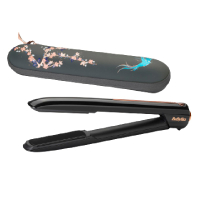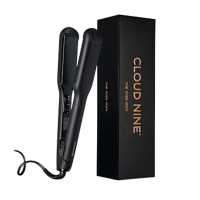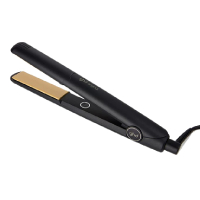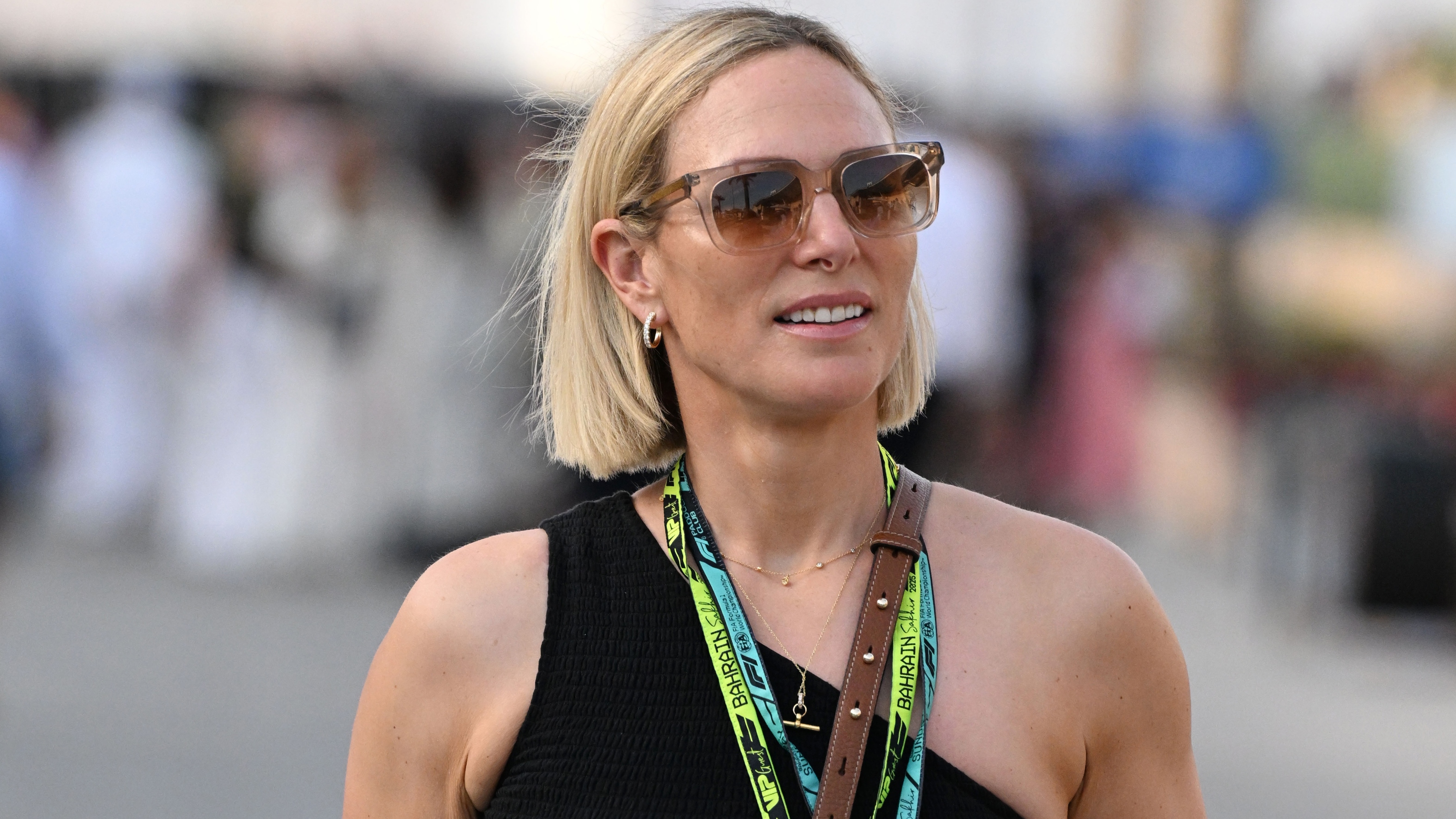Are ceramic straighteners bad for your hair? A complete guide
Are ceramic straighteners good or bad for your hair? We’ve asked the experts to see how these plates compare

Wondering are ceramic straighteners bad for your hair? Straighteners have been around for long enough for us to know that whether you’re using ceramic or titanium, they’re going to cause some level of damage. But, what we also know is that heat styling is a fast-track route to sleek, shiny hair with a super smooth finish.
Over the years, what we want from the best straighteners has changed. It’s no longer all about a poker-straight finish and an acceptance of split ends as part and parcel of that. Now we want to be able to straighten, wave and curl hair without causing too much damage, so we need to look more closely at materials. Most straightener models have either ceramic, titanium, or copper plates. It’s worth noting that just as jewelry can be gold plated as opposed to real gold, straightening iron plates can be another material, like aluminum, topped with a ceramic or tourmaline coating.
Ceramic hair straighteners are made from elements like clay, which have been shaped at high temperatures and are non-metallic (which means they don’t conduct heat quite as intensely as metals do) They have a glossy finish that translates into smooth styling and are generally considered to be effective without causing excess damage. So, in the interest of good hair days, we asked the experts if our preconceptions were correct, and how ceramic matched up with other materials.
Are ceramic straighteners bad for your hair? Ceramic straightener 101
What are the benefits of ceramic hair straighteners?
“Ceramic plates are used to ensure heat is evenly distributed across the entire plate,” explains Ricky Walters, Director of Salon64. “This even distribution of heat means that you don’t need to use such a high temperature when styling, making them a better option for your hair’s health and condition.” On that note, the second benefit is that they take a kinder approach than metal. “As ceramic plates heat the hair from the inside out, they cause less damage,” says Belle Cannan founder of Salon Sloane. “They’re gentler on the hair.”
The third pro is ceramic straighteners' ability to work fast on fluffiness. “Ceramic straighteners create negative ions, which means less frizz,” says Natalia Vera, Expert Stylist & Educator at Live True London. We know negative sounds, well, negative, but in this instance, it’s actually positive (confusing, we know). When hair has been heat-styled or bleached, positive ions can cause the hair cuticle to open – leading to dryness and damage. Negative ions cancel out positive ones, helping to smooth the cuticle, and taming fluff, frizz, and flyaways. This means you shouldn’t need to tug or create too much tension (which can lead to snapping and snagging) to achieve a smooth finish.
Finally, ceramic straighteners are great for hydration. “Ceramic plates help to capture the hair’s moisture to stop your hair from feeling too dried out or dehydrated after use,” says Ricky. Heat is often required to activate smoothing and straightening treatments for the hair, making ceramic plates the best tool for the job without compromising hair health.
What are the downsides of ceramic straighteners?
Now for the big question, are ceramic straighteners bad for your hair? The potential problems with ceramic hair straighteners come from the nature of the material. You want the plates to be fully ceramic, rather than ceramic coated, but they are then fragile and can be broken if dropped on a hard surface or tumbled around in a suitcase.
If your straighteners have a ceramic coating or plating, they’re likely to be metallic underneath, which can take away some of the benefits – especially when it comes to evenly distributing heat across the plates. This coating isn’t necessarily long-lasting and can come apart too. “The ceramic plating can chip, exposing metals like aluminum which can catch, split and damage the hair,” adds Craig Taylor, Creative Director at Hari’s Hairdressers. Taking good care of your straighteners by storing them carefully and tucking them into a padded case when traveling will help to minimize the likelihood of this happening.
What are the alternatives to ceramic hair straighteners?
- Titanium: “If you’re not using ceramic hair straighteners, your other main material is titanium,” explains Walters. “This is a tougher, far more durable material and therefore should certainly last you a long time. These irons tend to be much more heavy-duty, so are perhaps better for thicker, more stubborn hair.” Those with fine or fragile hair would probably be better suited to ceramic plates, as titanium may be a bit overwhelming for this hair type. But for those looking for the best straighteners for curly hair, it’s definitely a good option.
- Tourmaline: "Anything infused with tourmaline would be my choice of straightener,” says Taylor. “It can distribute heat more evenly and smooth hair at a lower temperature.” Tourmaline is a crystal that hair tool manufacturers grind into a fine powder, which is infused into the plates – whether ceramic or titanium – of a straightening iron. It’s an added extra, rather than the main material. “Tourmaline makes for a more premium iron and helps to prevent damage, overheating, and static on the hair,” explains Walters. “Cloud Nine infuses healing minerals into all of its ceramic straightening irons.”
- Copper: Another option to note for straightening iron plates is copper. It’s used by Revlon, and also forms part of the plates of the Dyson Corrale hair straightener. While Revlon uses copper alone, Dyson has formulated a “complex manganese copper alloy plate” which is a combination of six different metals for maximum flexibility and strength, as well as optimum heat conduction.
Ceramic vs titanium hair straighteners
“The main difference between ceramic and titanium plates is how they heat the hair,” explains Vera. “Ceramic plates heat the hair from the inside out, while titanium heats from the surface of the hair shaft, meaning ceramic can be more gentle than titanium. “The other main difference is heating time,” she continues. “You’ll find that titanium heats almost instantly, which makes it great for salon use. Ceramic takes longer to heat up, which in the long run can be better for your hair.”
With this logic, titanium is best for thicker hair that needs more heat and can take it without showing too much damage, while ceramic is better for fine, fragile hair which requires a lighter touch.
Ultimately, not all stylists and experts think the plate has a huge impact. “I firmly believe that it’s not the surface that makes the difference,” explains Taylor. “Instead, it’s the temperature they operate effectively at. For me, the best solution is to use a flat iron with tourmaline-infused plates and turn the heat down to under 356°F (180ºC).” While not all straighteners will give you the option to change the temperature, many will, putting you in control of how hot you go. You might, for example, need to use more heat after washing, but less on day two or three.
The verdict: Are ceramic straighteners bad for your hair, or better?
Like any tool that exposes your hair to heat, ceramic straighteners can, of course, cause damage. However, the same can be said for the best hair straightener brushes on the market, or pretty much any mechanical or heat-styling tool out there. “Try to use hair tools sparingly,” advises Walters. “Even the best ceramic irons still create a fair amount of heat, so I’d try not to use them every day.”
But, if like many of us, you can’t make it through the week without reaching for your flat iron at least a handful of times, ceramic plates are as good an option as any. The even distribution of heat, the fact they’re gentler on the hair, and their ability to banish frizz fast make them well-suited to fine hair or hair prone to damage. On the flip side, those with coarse or curly hair may find they need to do more passes through the hair to straighten with a ceramic tool than a titanium one, effectively canceling out the benefits.
Ultimately, it's true that stopping using straighteners altogether would be the ultimate way forward when it comes to healthy hair, but that’s a challenge for another day.
Our top ceramic straighteners

Babyliss 9000 Cordless Straightener | RRP: $245 / £200
Great for on-the-go, these cordless straighteners will reward you with 30 minutes of use at maximum temperature after a 3-hour charge. The ultra-smooth ceramic plates glide through hair beautifully.

Cloud Nine The Wide Iron | RRP: $200 / £169
A brilliant buy for thick hair, these wide plates allow you to straighten and smooth large sections at once. The mineral-infused ceramic plates leave hair super shiny while the adjustable temperature lets you choose how hot you want to go.

GHD Original Styler | RRP: $169 / £109
When most people think of straighteners, it’s GHD that springs to mind first. Their Original Styler uses ceramic technology for optimum styling temperature (185°C) across both plates. They’re glossed too, for an extra shiny finish.
Sign up for the woman&home newsletter
Sign up to our free daily email for the latest royal and entertainment news, interesting opinion, expert advice on styling and beauty trends, and no-nonsense guides to the health and wellness questions you want answered.
Jess Beech is an experienced fashion and beauty editor, with more than eight years experience in the publishing industry. She has written for woman&home, GoodtoKnow, Now, Woman, Woman’s Weekly, Woman’s Own and Chat, and is a former Deputy Fashion & Beauty Editor at Future PLC. A beauty obsessive, Jess has tried everything from cryotherapy to chemical peels (minus the Samantha in Sex and The City-worthy redness) and interviewed experts including Jo Malone and Trinny Woodall.
-
 Royal style made casual - Zara Tindall's one-shoulder dress, denim jacket and Aspinal bag are the epitome of chic summer comfort
Royal style made casual - Zara Tindall's one-shoulder dress, denim jacket and Aspinal bag are the epitome of chic summer comfortZara Tindall's outfit in Bahrain was a more relaxed take on her signature style and was made up of timeless staples.
By Emma Shacklock Published
-
 All the lessons we've learned from Professor Tim Spector on optimising your health and wellbeing
All the lessons we've learned from Professor Tim Spector on optimising your health and wellbeingIf anyone's qualified to give us lessons on how to eat better, it's Professor Tim Spector - and these are his best lessons
By Grace Walsh Published

